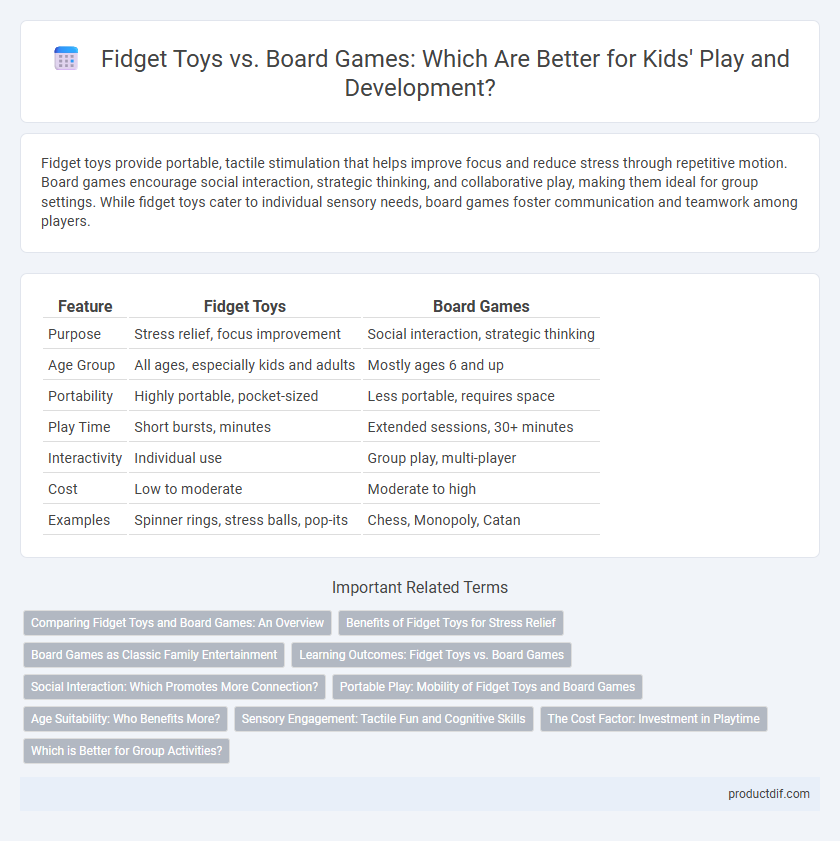Fidget toys provide portable, tactile stimulation that helps improve focus and reduce stress through repetitive motion. Board games encourage social interaction, strategic thinking, and collaborative play, making them ideal for group settings. While fidget toys cater to individual sensory needs, board games foster communication and teamwork among players.
Table of Comparison
| Feature | Fidget Toys | Board Games |
|---|---|---|
| Purpose | Stress relief, focus improvement | Social interaction, strategic thinking |
| Age Group | All ages, especially kids and adults | Mostly ages 6 and up |
| Portability | Highly portable, pocket-sized | Less portable, requires space |
| Play Time | Short bursts, minutes | Extended sessions, 30+ minutes |
| Interactivity | Individual use | Group play, multi-player |
| Cost | Low to moderate | Moderate to high |
| Examples | Spinner rings, stress balls, pop-its | Chess, Monopoly, Catan |
Comparing Fidget Toys and Board Games: An Overview
Fidget toys and board games both provide unique forms of engagement, with fidget toys offering tactile stimulation and stress relief through repetitive motions like spinning or squeezing. Board games encourage social interaction, strategic thinking, and extended play sessions, appealing to groups and families. Choosing between these depends on preferences for solitary sensory input versus collaborative, rule-based entertainment.
Benefits of Fidget Toys for Stress Relief
Fidget toys provide instant tactile engagement that helps reduce anxiety and improve focus, making them ideal for stress relief during short breaks. Unlike board games, which require extended social interaction and cognitive effort, fidget toys offer a discreet and portable way to manage restlessness and calm the nervous system. Scientific studies show that sensory stimulation from fidgeting can lower cortisol levels and enhance mood regulation effectively.
Board Games as Classic Family Entertainment
Board games remain a timeless choice for family entertainment, promoting social interaction, strategic thinking, and collaborative problem-solving across generations. Unlike fidget toys, which primarily target individual sensory engagement, board games encourage shared experiences and foster lasting memories. Classic board games like Monopoly, Scrabble, and Clue continue to be popular for their ability to bring families together in meaningful, screen-free play.
Learning Outcomes: Fidget Toys vs. Board Games
Fidget toys enhance fine motor skills, improve concentration, and reduce anxiety by providing tactile stimulation that supports sensory processing. Board games foster critical thinking, social interaction, and strategic planning through collaborative play and rule-based challenges. Combining both can create a balanced learning environment that addresses cognitive and emotional development effectively.
Social Interaction: Which Promotes More Connection?
Fidget toys primarily provide individual sensory stimulation, making them less effective for fostering social interaction compared to board games. Board games inherently require players to engage, communicate, and collaborate, promoting stronger social bonds and teamwork. Research shows that interactive play in board games enhances social skills and connection more significantly than solitary use of fidget toys.
Portable Play: Mobility of Fidget Toys and Board Games
Fidget toys offer exceptional portability due to their compact size, allowing users to engage in sensory play anywhere, from classrooms to commuting. Board games, by contrast, often require a flat surface and multiple components, making them less convenient for mobile play but ideal for social gatherings. The mobility of fidget toys supports on-the-go stress relief, while board games encourage interactive, stationary entertainment.
Age Suitability: Who Benefits More?
Fidget toys are particularly beneficial for children aged 4 to 12, offering sensory stimulation and helping improve focus and fine motor skills. Board games typically suit a wider age range, from 6 years to adults, promoting strategic thinking, social interaction, and cooperative play. Younger children may find fidget toys more accessible, while older kids and families gain greater developmental and social benefits from board games.
Sensory Engagement: Tactile Fun and Cognitive Skills
Fidget toys provide continuous sensory stimulation through tactile interaction, enhancing fine motor skills and focus during repetitive hand movements. Board games promote cognitive development by encouraging strategic thinking, problem-solving, and social engagement among players. Both toys support sensory engagement, with fidget toys emphasizing tactile fun and board games fostering complex cognitive skills.
The Cost Factor: Investment in Playtime
Fidget toys generally offer a lower initial cost compared to board games, making them a budget-friendly choice for continuous playtime. Board games require a higher upfront investment but provide longer-lasting entertainment with social interaction benefits. Considering cost per hour of engagement, fidget toys may be more economical for solo play, while board games deliver greater value through extended group play experiences.
Which is Better for Group Activities?
Board games foster collaboration and social interaction, making them ideal for group activities by encouraging communication, strategic thinking, and teamwork among participants. Fidget toys primarily serve individual focus and stress relief, offering limited group engagement or cooperative play. For dynamic group settings, board games provide a more inclusive and interactive experience.
fidget toys vs board games Infographic

 productdif.com
productdif.com